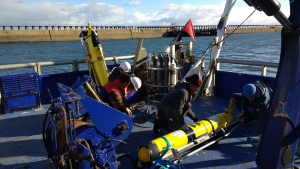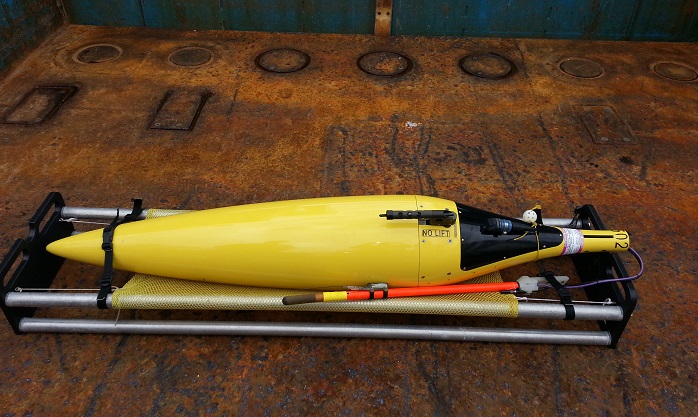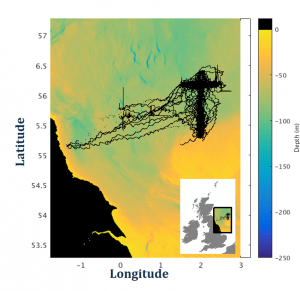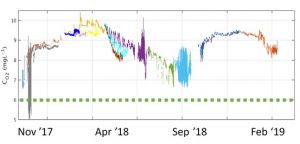Marine
Use of new technologies to better understand changes in oxygen levels in the North Sea
June 8, 2021 by MS Communications No Comments | Category Marine Directorate Science, Oceanography
The Scotland’s Marine Assessment 2020 portal provides a range of information on the health of our seas and how to determine the state of marine ecosystems.
One example is the NERC-funded (Natural Environment Research Council) AlterEco project, which is an alternative framework to assess marine ecosystem functioning in shelf seas. This project carried out successful research using novel autonomous technologies for recording and monitoring oxygen levels in North Sea waters, as well as parameters that influence its state, such as temperature and nutrient concentrations. Oxygen contained in water, also called dissolved oxygen, is essential for the survival of most marine organisms.
The AlterEco project collected data between 2017 and 2019 from a total of 18 ocean gliders – autonomous robotic vehicles that were deployed at sea for several months at a time, as seen below. The aim was to improve the coverage of measurements of dissolved oxygen and nutrient concentrations in both time and over large areas, investigate what might cause observed levels of reducing oxygen (deoxygenation) and form a better understanding of the ecological health of the North Sea.
The project launched gliders from the coastal waters off Blyth, Northumberland, towards Dogger Bank, mostly using the small coastal vessel Research Vessel (RV) Princess Royal, University of Newcastle, and was supported by Marine Research Vessel Scotia, Marine Scotland and RV Endeavour, Centre for Environment, Fisheries and Aquatic Science (CEFAS).
These gliders were used to collect observations along two perpendicular transect lines, repeated back and forth, and also at a single location (replicating a traditional ship survey with extremely high sampling rates). The map below shows the cross-shaped transect lines, one east-west at 56.2º N, and the second north-south transiting between shallower water on Dogger Bank in the south to deeper regions in the north. There were occasional diversions when technical problems or bad weather pushed the gliders off course. The results demonstrate that the deeper sea regions north of Dogger Bank undergo periods of prolonged vertical stratification, when distinct density layers occur within the water column from spring (early April).
Oxygen levels are known to follow seasonal changes, and the gliders captured this cycle -. in spring the water goes from being completely mixed, to vertically stratified, when distinct layers form due to seasonal warming. At this time, a surface warm layer becomes separated from the deeper, cooler layer. The dissolved oxygen concentration in this cool bottom layer decreases dramatically during this stratified period that extends through spring, summer and autumn, as microbial organisms respire and so use up available oxygen. In some locations, oxygen levels reached the limits of what is considered a healthy threshold value of 6 mg L–1 by the end of the late autumn (see figure below). Luckily, UK shelf waters typically revert to being well mixed in winter, as was observed during the AlterEco measurement period, and these waters once again become oxygenated. This observed decrease does give cause for concern, particularly if future changes might push oxygen levels lower.
Heat fluxes, gas exchange and water depth also play their part in variations in oxygen concentrations in the water. Oxygen is less soluble in warmer water than colder water, which leads to oxygen concentration decreasing when the warming water mirrors the atmosphere, and increasing when the water cools. Water depth controls the volume of water that is not impacted by air . Nutrient concentrations, light availability and biological productivity also play a critical role in changing oxygen levels as the growth of phytoplankton, (microscopic marine plants) both contribute to increasing oxygen levels, just as plants do on land, but also fuel the microbial depletion of oxygen in the deeper water.
Future threats to this system from climate change include predicted rising sea temperatures, which would make water less able to hold onto its dissolved oxygen, longer and stronger periods of stratification and increases in phytoplankton production, with some areas of the North Sea already approaching oxygen deficient levels measuring close to the 6 mg L–1 threshold – a level which may be unsuitable for some organisms.
Long term continuous glider time series from AlterECO showing bottom oxygen concentration in the North Sea, red line showing the threshold at 6 mg –-1 for ‘healthy waters’. Each colour on the figure represents the measurements made by one glider.
Aside from these important scientific results, AlterEco also demonstrated the capability for autonomous sustained ocean observing using ocean gliders. These technologies delivered high-resolution sampling of multiple ocean measurements over large sea areas and with only limited assistance from large research ships. Additional project benefits included the trialling and testing of new sensors and important developments in sensor calibration and data quality assurance using ocean gliders.
Looking forward, the state of the art data collected in AlterEco will be used alongside numerical models to demonstrate how observations of this type can contribute to assessments of the health and environmental status of Scottish and UK seas, and how observed changes are influenced by human activity, climate change and naturally occurring cycles.
Tags: AlterEco, AlterEco project, Dissolved Oxygen, research, science





Leave a comment